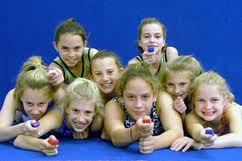 By Martha Gabler MA
By Martha Gabler MA
The purpose of this article is to introduce you to a new type of support for children with autism: the acoustical support. Most people are familiar with adaptive equipment for children with physical disabilities such as wheel chairs, braces, and work platforms. In the autism community, most people are familiar with visual supports: picture systems, schedules, token boards, and so forth. These visual supports play a crucial role in educating children with autism and have proven to be extremely useful in both home and school settings.
Introducing the acoustical support
Now, for the “acoustical” support: An acoustical support is a neutral sound: a tap, click or ping. The purpose of the sound is to inform a learner that he has done something right. The sound says, “YES, you did it.” The instructor, therapist or parent makes the sound at the exact moment that the child has performed a desired behavior. This behavior may be pointing to a picture of a cat, putting a puzzle piece into place, or, one of those rare beautiful flashes of meaningful eye contact or comprehension. As soon as the child has performed the task and the instructor has produced the sound, the child receives a treat (reinforcer). After a few trials, the neutral sound becomes a “conditioned reinforcer.” Behavior scientist Karen Pryor explains, “A conditioned reinforcer is some initially meaningless signal—a sound, a light, a motion—that is deliberately presented before or during the delivery of a reinforcer.”
The child starts to pay attention
After a few experiences of hearing the sound and receiving a treat (reinforcer), the sound itself becomes meaningful for the child, and he starts to watch out for it. After the child is paying attention to the sound, he starts to pay attention to the behaviors that produced the sound. When he realizes that his own behaviors are producing the sound and the reinforcer, he learns to produce those desired behaviors more often. At that point, you have
learning and communication! The use of a sound to signal success to the learner is called Teaching with Acoustical Guidance or TAGteach.
As a parent, when I started using a neutral sound (a “tag” or click) to indicate to my son which behaviors of his would earn treats, he started doing more of those behaviors. My son was loud, chaotic and wild in the early years. He had self-stimulatory and aggressive behaviors. With my conditioned reinforcer (sometimes referred to as an “event marker” or a “tag”), I was able to tag my child every time he did something good. “Good” things were behaviors like Quiet Mouth, Both Feet On The Floor, Hands Still, or Eye Contact. The procedure is: Observe child, press clicker (tag) when child performs the desired behavior, then reinforce child (give a treat or token).
Tantrum busting
The first time I ever used a TAGteach acoustical support, my son had just erupted into a tantrum, complete with shrieking, stomping and storming about. I tagged every split second of “Quiet Mouth” or “Both Feet On The Ground,” and handed him a tiny piece of candy with each “tag.” Twelve minutes later he was sitting quietly and calmly on the sofa, and we were able to go about our day. During those twelve minutes I said not a word and did nothing other than press the tagger and hand out tiny pieces of candy. It was easy to do, and the result was amazing. It was an incredibly empowering experience for me, compared to all the previous tantrums when I always felt panicky, demoralized and helpless. I never feared a tantrum or meltdown again because I had a powerful tool to help him calm down.
 My son became more skilled and happier the more I tagged
My son became more skilled and happier the more I tagged
The more I communicated with my son via tags and positive reinforcement, the more skills he gained and the happier and better behaved he became. Despite the lack of speech, despite the sensory issues, the tag rang loud and clear and told him he had done something good. He loved it and responded beautifully. He had many difficult behaviors, but I was able to tag a split second of a good behavior whenever it occurred, with the result that the split second became two seconds, then three seconds, then four seconds of the desired behavior, plus it occurred more often. Gradually I was able to “shape” disruptive behaviors into positive learning behaviors, and he gained many useful skills.
Clear, precise information for the child with no emotional or sensory burden
The reason the tag works so well is because of the precise information it provides to the child. It tells the child, in real time, exactly what he did that was right, at exactly the moment he did it. From the viewpoint of a child with autism, he receives precise, timely information from a neutral sound; there is no emotional burden, language processing or sensory issue to deal with. Thus the child is free to focus on the priceless information he is receiving: the wonderful knowledge that he has done something right.
The time has come for TAGteach for autism
The time has come for the use of acoustical supports in the autism community. There are many reasons. From an autism family's perspective, this method is wonderful because it is easy, effective and low cost. From an autism treatment perspective, this method is wonderful because it is based on the scientific principles of Applied Behavior Analysis. It is flexible, portable and wonderful for teaching in the natural environment as well as in structured settings. It is an invaluable tool for weary, dispirited parents, and for over-burdened instructors in the classroom.
Thank you for reading to the end of this article! I hope you are interested in learning more about using acoustical supports for a child with autism. If you have questions, please contact me via the
Questions for Martha link on her blog.
For more information on TAGteach and autism please visit:
tagteach.com/Autism_and_Special_Education
About Martha

Martha Gabler is the mother of a non-verbal teenager with severe autism. She holds a Bachelor's degree from Vassar College and a Master's degree from the George Washington University Martha lives in Silver Spring, Maryland with her husband and two sons. Her older son is at university pursuing a degree in mathematics. Martha runs a tutoring company called
Kids' Learning Workshop LLC, and is the author of the book entitled
Chaos to Calm: Discovering Solutions to the Everyday Problems of Living with Autism. Martha writes articles to help other autism parents solve or prevent behavior problems at her blog:
www.AutismChaosToCalm.com. Martha loves to hear from readers and to answer questions at her
Facebook page.






























